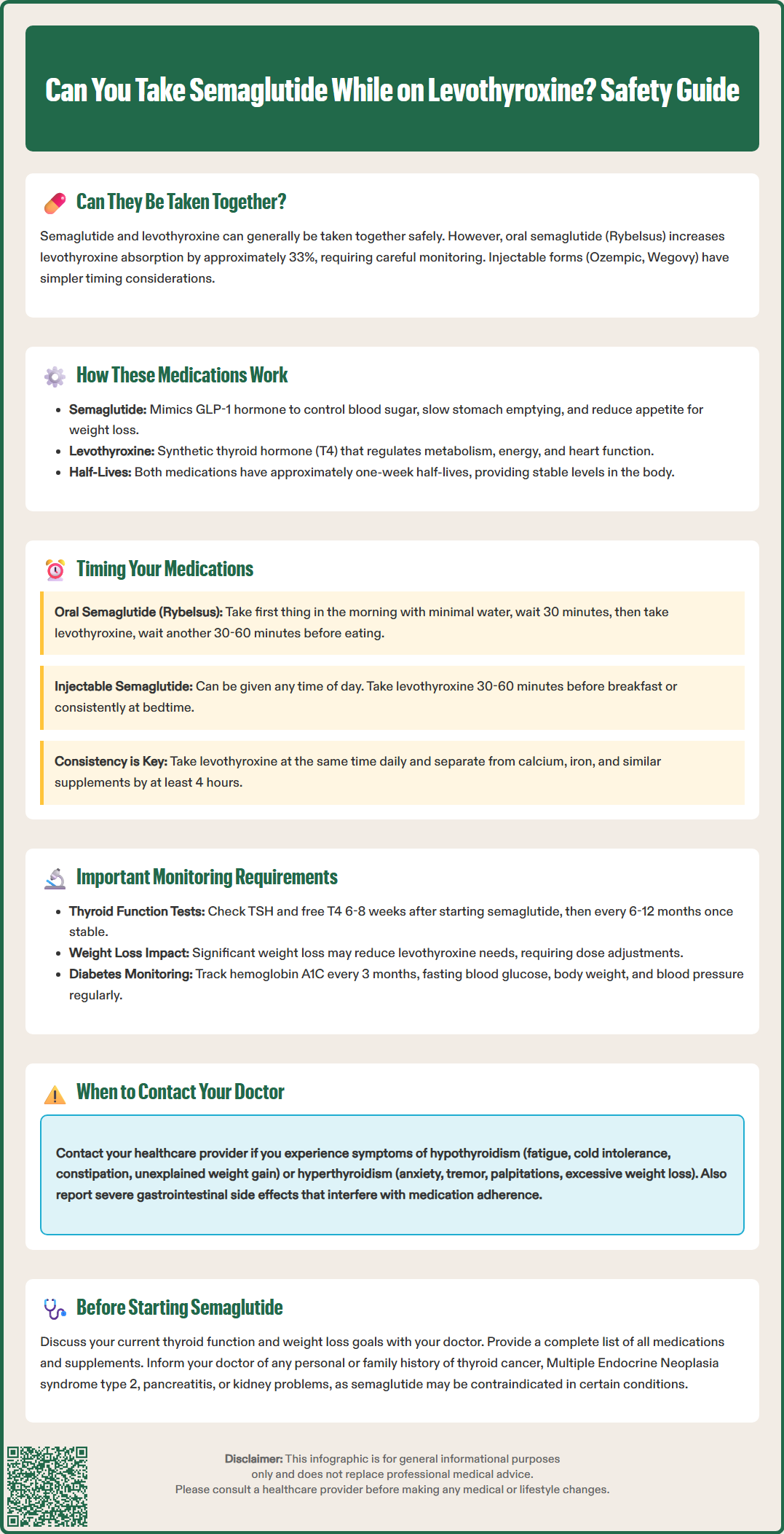LOSE WEIGHT WITH MEDICAL SUPPORT — BUILT FOR MEN
- Your personalised programme is built around medical care, not willpower.
- No generic diets. No guesswork.
- Just science-backed results and expert support.
Find out if you’re eligible

Can you take semaglutide while on levothyroxine? Yes, these medications can generally be used together safely, though specific timing and monitoring considerations apply. Semaglutide, a GLP-1 receptor agonist for type 2 diabetes and weight management, and levothyroxine, a thyroid hormone replacement for hypothyroidism, do not have absolute contraindications. However, oral semaglutide (Rybelsus) increases levothyroxine exposure by approximately 33% according to FDA labeling, and all semaglutide formulations slow gastric emptying, potentially affecting levothyroxine absorption. Proper medication timing, regular thyroid function monitoring, and dose adjustments during weight loss are essential for safe concurrent use under medical supervision.
Quick Answer: Semaglutide and levothyroxine can generally be taken together safely with appropriate timing and medical monitoring.
Yes, you can generally take semaglutide while on levothyroxine, though there are important considerations for proper administration and monitoring. While there is no contraindication between these medications, there are specific interactions that require attention, particularly with oral semaglutide (Rybelsus).
Semaglutide, marketed as Ozempic and Wegovy (injectable forms) and Rybelsus (oral form), is a glucagon-like peptide-1 (GLP-1) receptor agonist used for managing type 2 diabetes and chronic weight management. Levothyroxine is a synthetic thyroid hormone replacement with a narrow therapeutic index used to treat hypothyroidism.
Importantly, the FDA labeling for oral semaglutide (Rybelsus) indicates it can increase levothyroxine exposure by approximately 33% when taken together. Additionally, all forms of semaglutide slow gastric emptying, which may affect the absorption of oral medications, including levothyroxine.
Proper timing of these medications is crucial. For patients taking oral semaglutide, specific administration sequences are necessary to ensure optimal absorption of both medications. For those on injectable semaglutide, the timing considerations are less complex but still important.
Many patients with both type 2 diabetes or obesity and hypothyroidism safely take both medications together with appropriate medical supervision. Regular monitoring of thyroid function is essential, particularly when starting or adjusting semaglutide doses or experiencing significant weight changes.
Always inform all your healthcare providers about every medication you're taking, including over-the-counter supplements. Your doctor will consider your complete medical history, current thyroid function, diabetes control, and treatment goals when determining the optimal approach for your treatment.
Understanding how each medication functions helps clarify why they can typically be used together safely. Semaglutide mimics the action of naturally occurring GLP-1, a hormone released by the intestines after eating. It works through several mechanisms:
Enhances insulin secretion from pancreatic beta cells in a glucose-dependent manner
Suppresses glucagon release, reducing hepatic glucose production
Slows gastric emptying, which prolongs satiety and reduces appetite
Acts on brain appetite centers to decrease food intake and promote weight loss
Semaglutide is administered as a once-weekly subcutaneous injection (Ozempic, Wegovy) or as a daily oral tablet (Rybelsus). For Rybelsus, proper administration is critical: take upon waking with no more than 4 oz plain water at least 30 minutes before first food, beverage, or other oral medications. Semaglutide has a half-life of approximately one week and is primarily eliminated through protein degradation.
Levothyroxine is a synthetic form of thyroxine (T4), the primary hormone produced by the thyroid gland. Once absorbed, levothyroxine is converted in peripheral tissues to triiodothyronine (T3), the more active thyroid hormone. Thyroid hormones regulate numerous metabolic processes:
Basal metabolic rate and energy expenditure
Protein synthesis and cellular metabolism
Cardiovascular function including heart rate and contractility
Growth and development in multiple organ systems
Levothyroxine is typically taken once daily on an empty stomach, ideally 30-60 minutes before breakfast. Alternatively, according to the American Thyroid Association, levothyroxine may be taken consistently at bedtime (3-4 hours after the last meal) if morning timing conflicts exist. It has a long half-life of approximately seven days, providing stable hormone levels. Absorption occurs primarily in the small intestine, and the medication undergoes hepatic metabolism.

There are several important interactions to consider when taking semaglutide and levothyroxine together:
Pharmacokinetic Interaction with Oral Semaglutide: According to FDA labeling, oral semaglutide (Rybelsus) increases levothyroxine exposure by approximately 33% when coadministered. This interaction requires careful thyroid function monitoring and potential levothyroxine dose adjustments.
Gastric Emptying Effects: All forms of semaglutide significantly slow gastric emptying. The FDA labels for injectable semaglutide (Ozempic, Wegovy) specifically caution that this delay may impact the absorption of oral medications, which is particularly important for narrow therapeutic index drugs like levothyroxine.
Timing Challenges: Both oral semaglutide and levothyroxine require specific administration conditions. Practical timing strategies include:
For oral semaglutide users: Take Rybelsus first upon waking with ≤4 oz water, wait at least 30 minutes, then take levothyroxine, and wait an additional 30-60 minutes before eating
Alternatively, consider consistent bedtime levothyroxine dosing (3-4 hours after the last meal)
Weight Loss Considerations: Significant weight reduction from semaglutide therapy can alter thyroid hormone requirements. As body weight decreases, the dose of levothyroxine needed to maintain normal thyroid function may also decrease. Without dose adjustments, this could potentially lead to symptoms of overtreatment (hyperthyroidism).
Gastrointestinal Side Effects: Semaglutide commonly causes nausea, vomiting, and diarrhea, particularly during dose escalation. These symptoms could affect the consistent absorption of levothyroxine if they occur around the time of administration.
While semaglutide does not directly affect thyroid function at therapeutic doses, the FDA label includes a boxed warning about thyroid C-cell tumors observed in rodent studies, though the relevance to humans remains uncertain. Patients with a personal or family history of medullary thyroid carcinoma or Multiple Endocrine Neoplasia syndrome type 2 should not use semaglutide.
When taking semaglutide and levothyroxine concurrently, regular monitoring ensures both medications remain appropriately dosed and effective. Your healthcare provider will likely recommend the following monitoring schedule and parameters:
Thyroid Function Tests should be checked more frequently than usual during the initial months of semaglutide therapy and following any significant weight loss. Standard monitoring includes:
Thyroid-stimulating hormone (TSH) levels 6-8 weeks after starting or adjusting semaglutide, then every 6-12 months once stable
Free T4 levels if TSH results are abnormal or symptoms suggest thyroid dysfunction
More frequent monitoring with oral semaglutide due to the known pharmacokinetic interaction
Additional testing if you experience symptoms of hypo- or hyperthyroidism
Diabetes and Weight Parameters require ongoing assessment:
Hemoglobin A1C every 3 months if therapy changes or not at goal; at least twice yearly if stable and meeting targets (per ADA guidelines)
Fasting blood glucose and self-monitoring blood glucose logs
Body weight at each visit to track response and adjust medications
Blood pressure monitoring, as weight loss may affect cardiovascular parameters
Symptom Monitoring is equally important. Contact your healthcare provider if you experience:
Signs of hypothyroidism: increased fatigue, cold intolerance, constipation, weight gain despite semaglutide, depression, or cognitive changes
Signs of hyperthyroidism: anxiety, tremor, palpitations, heat intolerance, unexplained weight loss beyond expected, or insomnia
Severe gastrointestinal symptoms: persistent nausea, vomiting, or diarrhea that might affect medication absorption
Hypoglycemia symptoms: shakiness, sweating, confusion, or dizziness (particularly if also taking insulin or sulfonylureas)
Maintain a consistent schedule for taking levothyroxine—ideally at the same time each day. Separate levothyroxine from calcium, iron, and similar binding agents by at least 4 hours. Keep a symptom diary and medication timing log to bring to appointments to help your healthcare team make informed decisions about your treatment plan.
Open communication with your healthcare provider is essential when considering or currently taking both semaglutide and levothyroxine. Prepare for your appointment by gathering relevant information and formulating specific questions.
Before Starting Semaglutide (if already on levothyroxine), discuss:
Your current thyroid function status and most recent TSH results
How well-controlled your hypothyroidism has been and any recent dose adjustments
Your weight loss goals and how they might affect thyroid hormone requirements
The monitoring schedule for thyroid function during semaglutide therapy
Specific timing strategies for medication administration, such as:
If Already Taking Both Medications, address:
Any new symptoms that might indicate thyroid dysfunction
Changes in weight and whether levothyroxine dose adjustment is needed
Gastrointestinal side effects and their impact on medication adherence
Results of recent laboratory tests and what they mean for your treatment plan
Your current medication timing routine and any challenges with adherence
Be prepared to provide a complete medication list, including prescription medications, over-the-counter drugs, vitamins, and supplements. Some substances can affect levothyroxine absorption (such as calcium, iron, proton pump inhibitors) or interact with semaglutide. Bring all your medications to appointments when possible.
Discuss your complete medical history, particularly:
Personal or family history of thyroid cancer or Multiple Endocrine Neoplasia syndrome type 2
History of pancreatitis or severe gastrointestinal disease
Kidney function status
Other endocrine conditions, including diabetes complications
Your doctor may coordinate care with specialists such as an endocrinologist, particularly if you have complex thyroid disease or difficult-to-control diabetes. Don't hesitate to ask about the rationale behind monitoring schedules, what specific symptoms warrant immediate contact, and how to manage side effects. If you're seeing multiple providers, ensure they're all aware of your complete medication regimen to prevent conflicting advice or overlooked interactions.
For oral semaglutide (Rybelsus), take it first upon waking with no more than 4 oz water, wait at least 30 minutes, then take levothyroxine, and wait an additional 30-60 minutes before eating. Alternatively, you can take levothyroxine consistently at bedtime (3-4 hours after your last meal) to avoid morning timing conflicts.
Yes, significant weight loss from semaglutide may decrease your levothyroxine requirements. As body weight decreases, the dose needed to maintain normal thyroid function may also decrease, requiring regular thyroid function monitoring and potential dose adjustments by your healthcare provider.
Thyroid function tests (TSH and free T4) should be checked 6-8 weeks after starting or adjusting semaglutide, then every 6-12 months once stable. More frequent monitoring may be needed with oral semaglutide due to the known pharmacokinetic interaction that increases levothyroxine exposure by approximately 33%.
All medical content on this blog is created using reputable, evidence-based sources and is regularly reviewed for accuracy and relevance. While we strive to keep our content current with the latest research and clinical guidelines, it is intended for general informational purposes only.
This content is not a substitute for professional medical advice, diagnosis, or treatment. Always consult a licensed healthcare provider with any medical questions or concerns. Use of this information is at your own risk, and we are not liable for any outcomes resulting from its use.